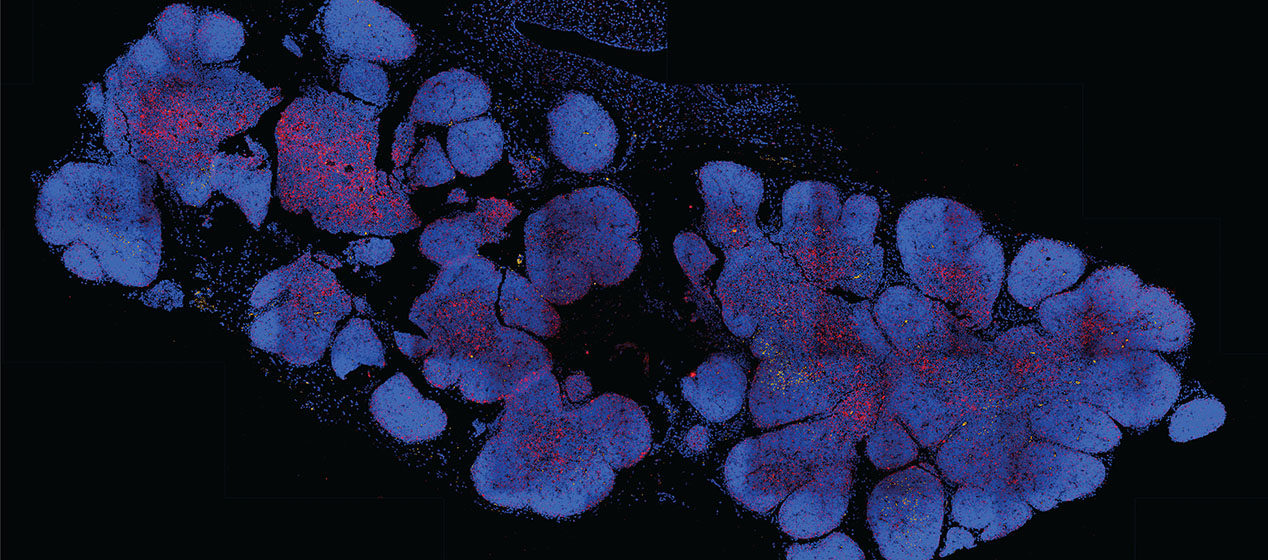
Published today in Science, this human thymus atlas has revealed new cell types and identified signals that tell immature immune cells how to develop into T cells. The atlas could also help scientists understand diseases that affect T cell development such as severe combined immunodeficiency (SCID), and adds to the Human Cell Atlas initiative which is creating a Google map of the entire human body.
The thymus gland is located in the chest and produces T cells, key white blood cells that fight infection and disease. These T cells then leave the thymus to enter the blood and other parts of the body to mature further. T cells seek out and destroy invading bacteria and viruses, and also recognise cancer cells and kill them.
Problems in thymus development causes defective T cell generation. This can result in severe immune deficiencies such as SCID, leaving people susceptible to infections. Alternatively, it can affect T cell regulation resulting in autoimmune diseases such as Type 1 diabetes. While mature T cells have been well studied, the development of the human thymus and T cells within it is not fully understood.
Researchers used single cell technology to isolate and analyse around 200,000 individual cells from the developing thymus, and child and adult thymus tissue. They looked at which genes were active in each individual cell to identify the cells, discovering new cell types, and used those genes as tags to map each cell to its exact location in the thymus.
"We have produced a first human thymus cell atlas to understand what is happening in the healthy thymus across our lifespan, from development to adulthood, and how it provides the ideal environment to support the formation of T cells. This openly available resource will allow researchers worldwide to understand how the immune system develops to protect our body."Therapeutic T cells are currently being used in the clinic to treat B-cell lymphoma and leukaemia cancers*, however a major drawback to these treatments is creating the right subtype of T cells.
Dr Jongeun Park, first author on the study from the Wellcome Sanger Institute
"With this thymus cell atlas, we are unravelling the cellular signals of the developing thymus, and revealing which genes need to be switched on to convert early immune precursor cells into specific T cells. This is really exciting as in the future, this atlas could be used as a reference map to engineer T cells outside the body with exactly the right properties to attack and kill a specific cancer - creating tailored treatments for tumours."
Professor Muzlifah Haniffa, a senior author of the study from Newcastle University and Senior Clinical Fellow at the Wellcome Sanger Institute
"We now have a very detailed understanding of how T cells form in healthy tissue. We have been able to identify a similar population of precursor cells in the developing thymus and liver, and we believe that these precursors are important for initiating T cell development in the foetus, and for the establishment of a fully competent thymus organ. This is helping us put jigsaw pieces together to get a bigger picture of how immunity develops."The thymus is unusual in that it is largest and most active in childhood and shrinks after puberty. The thymus has been called the 'pacemaker of life' and by age 35 has almost disappeared. Understanding how the thymus develops and then withers could cast light on aging and how the immune system changes through life.
Professor Tom Taghon, a senior author of the study from Ghent University, Belgium
"This map of the thymus is an important part of the Human Cell Atlas mission to chart every cell type in the human body. It is helping us learn about developmental pathways within the body, and the age-associated decline of the immune system. This has applications in cellular engineering, including the possibility of creating an artificial thymus for regenerative medicine."Publication:
Dr Sarah Teichmann, a senior author from the Wellcome Sanger Institute and co-chair of the Human Cell Atlas Organising Committee
J E Park et al. (2020). A cell atlas of human thymic development defines T cell repertoire Formation. Science. DOI: 10.1126/science.aay3224



Reader Comments
to our Newsletter